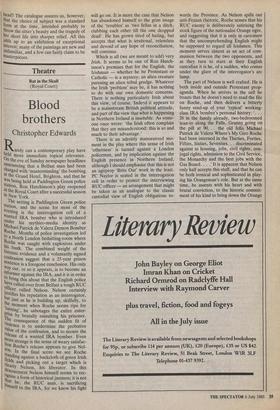Exhibitions
Around 1610: The Onset of the Baroque (Matthiesen Fine Art 61116 August)
Decorative and
macabre ,
David Wakefield The latest in a series of remarkable exhibitions held in recent years by the Matthiesen Gallery (7-8 Mason's Yard, Duke Street, SW1) is entitled Around 1610: The Onset of the Baroque. Though modestly described by the organiser as a sample of works from current stock, this exhibition provides striking illustration of a seminal period in the development of Italian painting, when the late Classicism of the Bolognese Caracci and Domenichi- no was confronted in Rome with the brutal 'realism' of Caravaggio and his followers. Indeed, it would be hard to imagine a more telling contrast between the restrained emotion of the Bolognese painters — in the suave polish of Albani's 'Mary Mag- dalen' or the Raphaelesque purity of Anto- nio Caracci's 'Martyrdom of St Praxedes' — and the violent contortions of Ribera's 'Prometheus' (condemned for his rebellion against Jupiter to daily visits by an eagle which pecked at his liver). At the same time such diametrically opposed works illustrate the central paradox of the Counter-Reformation — which dominated the entire artistic and political scene in Rome around 1600 — with its promises of angels, music and eternal bliss on the one hand, and dire threats of torture on the other. Never has imagery been so power- fully and effectively harnessed to religious dogma. Even more remarkable is the fact that the men who propagated the spirit of Catholic orthodoxy with such fervour were the gentlest of souls like St Ignatius Loyola, founder of the Society of Jesus. Here, in a beautiful and recently disco- vered altar-piece by Domenichino, the saint is portrayed at La Storm on the road to Rome, his pilgrim's hat and staff beside him, kneeling in enraptured vision of God the Father and Christ. This work, together with another painting of `St Francis Re- ceiving the Stigmata' by Orazio Gen- tileschi, are admirable examples of early 17th-century devotional art.
Rome, in fact, was the centre of the civilised world, not only for the followers of its religion, but for men of letters and artists from all countries. Some, like the French poet Du Bellay, disliked the city intensely with its incessant political in- trigue, and longed to be back in his native land. None, however, could escape the fascination of Rome. This fascination could induce the most strange and subtle modifications in the native genius, as the exhibition demonstrates from a group of Dutch artists from Utrecht who fell under the influence of Caravaggio, Joachim Wte- wael (1556-1638), Gerrit van Honthorst (1590-1656) and Matthias Stomer from Amersfoort. Stomer is represented by one powerful and vigorous work, 'The Calling of St Matthew', probably commissioned for a Roman church. Wtewael travelled m Italy in 1584 when he acquired all the trappings of the Mannerist style — bright enamel-like colour, flat, two-dimensional forms and a love of arabesque — grafted onto the native realism of Dutch painting. The bizarre result of this combination can be seen in his 'Jacob and Esau', in which the elder brother sells his birthright to the younger, Esau the hunter, for a mess of potage; the curiously elongated figures, the brilliant colours and the sleek forms of the hounds at their feet, all serve to reinforce the moral of this allegory of vice and greed. A less ambivalent and more obviously attractive work is Honthorst's 'Diana and her Nymphs Reposing'. Though by a fol- lower of Caravaggio, there is nothing typically Caravaggesque about this decora- tive painting of four buxom, healthy looking females. The Cravaggesque move- ment also had profound repercussions in 17th-century France. Two French exam- ples are exhibited here, Valentin's dark and mysterious 'Angel appearing to St Joseph'; and Aubin Vouet's faintly ridicu- lous 'David with the Head of Goliath' (waggishly described by Sir Ellis Water- house as ‘Seicento High Camp'), showing the hero decked out in a fancy plumed bat. The same mixed strain of the decorative and the macabre, running through the art of the entire period, can also be seen in Saraceni's 'Martyrdom of St Cecilia'. This extraordinarily rhythmical composition shows the saint kneeling between her executioner on the right, his naked sword sharply outlined against her crimson dress, and the angel on the left who points her clear road to heaven with an outstretched arm; the diagonal running continuously from the executioner to the angel's finger emphasises both the upward ascension and the positive certainty of the saint's faith. Carol Bononi's `St Barbara' is painted in the same courtly, elegant manner, though far more fluid in execution. The strangest work of all, however, and the one which most strikingly exemplifies the contradic- tions of this period, is Agostino Caracci's portrait of 'Olimpia Luna as Judith and Melchiorre Zoppio as Holofemes'. The painting was commissioned by Melchiorre Zoppio, Professor of Philosophy at Bolog- na, to commemorate his wife who died prematurely in 1592. The fact that the professor should have chosen to represent his late wife as Judith, a matronly double chinned figure holding a sword in one hand and her husband's head (Holofernes) in the other, might give rise to humorous speculation in the modem spectator. Did she really cause him such appalling suffer- ing that he saw himself as a decapitated
head? The catalogue assures us, however, that the choice of subject was a standard form at the time, intended probably to throw the sitter's beauty and the tragedy of her short life into sharper relief. All this adds up to an exhibition of exceptional interest; many of the paintings are new and unfamiliar, and a few can fairly claim to be masterpieces.



















































 Previous page
Previous page